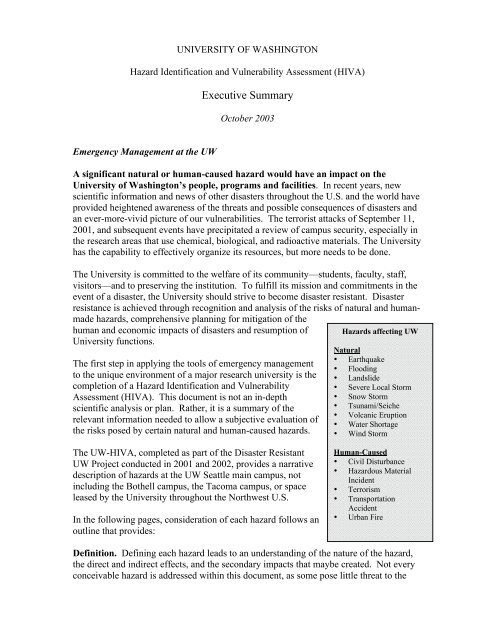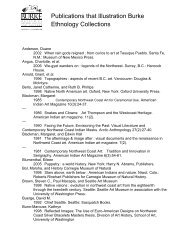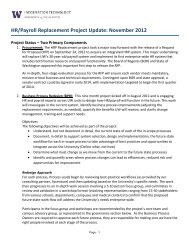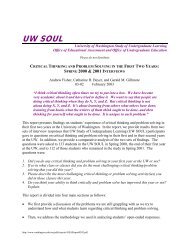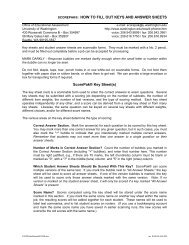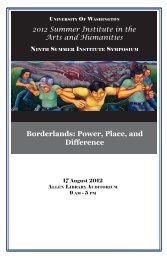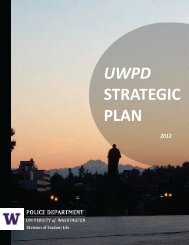UW Hazard Identification and Vulnerability Assessment (PDF)
UW Hazard Identification and Vulnerability Assessment (PDF)
UW Hazard Identification and Vulnerability Assessment (PDF)
You also want an ePaper? Increase the reach of your titles
YUMPU automatically turns print PDFs into web optimized ePapers that Google loves.
UNIVERSITY OF WASHINGTON<strong>Hazard</strong> <strong>Identification</strong> <strong>and</strong> <strong>Vulnerability</strong> <strong>Assessment</strong> (HIVA)Executive SummaryOctober 2003Emergency Management at the <strong>UW</strong>A significant natural or human-caused hazard would have an impact on theUniversity of Washington’s people, programs <strong>and</strong> facilities. In recent years, newscientific information <strong>and</strong> news of other disasters throughout the U.S. <strong>and</strong> the world haveprovided heightened awareness of the threats <strong>and</strong> possible consequences of disasters <strong>and</strong>an ever-more-vivid picture of our vulnerabilities. The terrorist attacks of September 11,2001, <strong>and</strong> subsequent events have precipitated a review of campus security, especially inthe research areas that use chemical, biological, <strong>and</strong> radioactive materials. The Universityhas the capability to effectively organize its resources, but more needs to be done.The University is committed to the welfare of its community—students, faculty, staff,visitors—<strong>and</strong> to preserving the institution. To fulfill its mission <strong>and</strong> commitments in theevent of a disaster, the University should strive to become disaster resistant. Disasterresistance is achieved through recognition <strong>and</strong> analysis of the risks of natural <strong>and</strong> humanmadehazards, comprehensive planning for mitigation of thehuman <strong>and</strong> economic impacts of disasters <strong>and</strong> resumption ofUniversity functions.The first step in applying the tools of emergency managementto the unique environment of a major research university is thecompletion of a <strong>Hazard</strong> <strong>Identification</strong> <strong>and</strong> <strong>Vulnerability</strong><strong>Assessment</strong> (HIVA). This document is not an in-depthscientific analysis or plan. Rather, it is a summary of therelevant information needed to allow a subjective evaluation ofthe risks posed by certain natural <strong>and</strong> human-caused hazards.<strong>Hazard</strong>s affecting <strong>UW</strong>Natural• Earthquake• Flooding• L<strong>and</strong>slide• Severe Local Storm• Snow Storm• Tsunami/Seiche• Volcanic Eruption• Water Shortage• Wind StormThe <strong>UW</strong>-HIVA, completed as part of the Disaster Resistant<strong>UW</strong> Project conducted in 2001 <strong>and</strong> 2002, provides a narrativedescription of hazards at the <strong>UW</strong> Seattle main campus, notincluding the Bothell campus, the Tacoma campus, or spaceleased by the University throughout the Northwest U.S.In the following pages, consideration of each hazard follows anoutline that provides:Human-Caused• Civil Disturbance• <strong>Hazard</strong>ous MaterialIncident• Terrorism• TransportationAccident• Urban FireDefinition. Defining each hazard leads to an underst<strong>and</strong>ing of the nature of the hazard,the direct <strong>and</strong> indirect effects, <strong>and</strong> the secondary impacts that maybe created. Not everyconceivable hazard is addressed within this document, as some pose little threat to the
University, e.g., avalanche or wildfire. Also the <strong>UW</strong>-HIVA does not deal with epidemicsor p<strong>and</strong>emics, which are considered to be under the purview of state <strong>and</strong> local publichealth organizations.The list of potential hazards is long; however these three pose the greatest threat:• Earthquake. Earthquake is the most destructive hazard the University faces. Threemajor earthquakes have affected the <strong>UW</strong> in the past 52 years (1949, 1965, <strong>and</strong> 2001).New information about the nature <strong>and</strong> extent of the seismic threats in Seattle <strong>and</strong> thePuget Sound region increases the urgency for <strong>UW</strong> planning. The majority ofpotential damage <strong>and</strong> casualties would come from building damage <strong>and</strong> the effects ofunsecured equipment <strong>and</strong> other non-structural elements throughout campus buildings.The secondary hazards of fire <strong>and</strong> hazardous materials releases could be expected toeasily overwhelm the University’s resources. If the University prepares/mitigates forearthquake, the impacts of the other hazards would be managed as well.• Terrorism. The inherent open environment of an academic research institutionmakes the <strong>UW</strong> vulnerable to terrorist attack. A large population moving freelyaround the campus makes it difficult to track activities of individuals who mightchoose to harm the University’s people, programs, or properties. Large, highlyvisible concentrations of University people could be at risk from external as well asinternal threats. Terrorism includes Chemical, Biological, Radiological, Nuclear,Explosive <strong>and</strong> Cyber-terrorism threats <strong>and</strong> incidents.• Urban Fire. Within minutes a fire can wipe out decades of research <strong>and</strong> millions ofdollars worth of equipment. While the direct effects of even a large urban fire aregenerally limited to the immediate area of the fire, emergency services to theUniversity could be adversely affected if large urban fires occur in other areas of thecity, thereby reducing <strong>and</strong> slowing Seattle Fire Department’s response to the <strong>UW</strong>campus.History. An important facet of this hazard analysis is the historical data relating theUniversity’s experience with the impacts of hazards in the past. This history providescrucial documentation of the reality of such hazards <strong>and</strong> helps to calibrate planning <strong>and</strong>preparedness efforts. Unfortunately, most historical documentation of past events at theUniversity is not well catalogued.Vulnerabilities. The main goal of the HIVA is to assess the vulnerability of theUniversity’s people, property, <strong>and</strong> environment to hazards. This assists in providingnecessary information to estimate the socio-economic impacts of disasters <strong>and</strong> to developstrategies for mitigation <strong>and</strong> emergency preparedness. These major vulnerabilities havebecome clear through the HIVA process:• The University can be isolated from non-campus resources during a significant event.Such an event would most likely be a regional earthquake, but also it could includesevere weather or a terrorist attack.
• The University’s operations comm<strong>and</strong> capability would be limited during an eventthat compromises the existing <strong>UW</strong> Emergency Operations Center at the BryantBuilding. Such an event could be an earthquake, seiche, localized fire, or terroristattack.• Significant research could be lost in the event of terrorist attack, earthquake, or fire.Not only would such losses affect the specific research programs, but also the statureof the University <strong>and</strong> other research institutes relying on the University’s resourcescould be adversely affected.• Students <strong>and</strong> other members of the campus community are particularly vulnerable toinjury from events, either directly or as a result of heroic actions. Injuries could resultfrom falling objects during an earthquake, or from performing heroic actions whileattempting to save lives.Effects. Creating a worst-case scenario provides information about the potential locationof damage, the amount of l<strong>and</strong> area that could be affected, <strong>and</strong> the severity of certaintypes of hazards.Recommended ActionsRecommendations for mitigation steps for each of the hazards are contained in the fullHIVA (a separate document). These form the basis for a formal <strong>UW</strong>’s <strong>Hazard</strong> MitigationPlan, the next step toward developing a disaster resistant university.The following general recommendations are not hazard-specific, but attention to themwould improve the University’s planning.• Improve record keeping on the damage, costs <strong>and</strong> effects of emergencies to aid futureplanning <strong>and</strong> mitigation efforts.• Shift <strong>UW</strong> maps/records to the same geographical coordinates as the GIS(Geographical Information System) used by the city, state, <strong>and</strong> federal government.• Assess hazards <strong>and</strong> vulnerabilities when making space allocation decisions forUniversity activities.Future DirectionThe <strong>UW</strong> is vulnerable to significant natural <strong>and</strong> human-caused hazards. The HIVAdemonstrates what is at risk <strong>and</strong> provides ample reason for continuing the emergencyplanning process. Moreover, it is clear that the University has the capability toeffectively organize its resources <strong>and</strong> to develop mitigation strategies to minimizethe impact of future disasters.For More Information – Please contact the <strong>UW</strong> Office of Emergency Management at(206) 897-8000.


